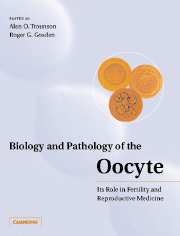Book contents
- Frontmatter
- Contents
- List of contributors
- Preface
- Part I Historical perspective
- Part II Life cycle
- 2 Ontogeny of the mammalian ovary
- 3 The early stages of follicular growth
- 4 Modelling the dynamics of ovarian follicle utilization throughout life
- 5 Comparative aspects of oogenesis
- Part III Developmental biology
- Part IV Pathology
- Part V Technology and clinical medicine
- Index
5 - Comparative aspects of oogenesis
from Part II - Life cycle
Published online by Cambridge University Press: 05 August 2016
- Frontmatter
- Contents
- List of contributors
- Preface
- Part I Historical perspective
- Part II Life cycle
- 2 Ontogeny of the mammalian ovary
- 3 The early stages of follicular growth
- 4 Modelling the dynamics of ovarian follicle utilization throughout life
- 5 Comparative aspects of oogenesis
- Part III Developmental biology
- Part IV Pathology
- Part V Technology and clinical medicine
- Index
Summary
Introduction
Over the last decade, the technologies for analysing developmental mechanisms at the molecular and genetic level have improved dramatically for mammalian systems. The human genome is sequenced. Polymerase chain reaction techniques using very small amounts of tissue enable the determination of which genes are expressed in which tissue. In situ hybridization methods using cloned genes as probes display the spatial expression patterns of genes, and antibodies can be used to visualize the expression patterns of proteins. Transgenic approaches in the mouse are now highly sophisticated and microarray techniques will soon allow detailed comparison of expression patterns of genes in different cells and at different times in development, and proteomics permits comparisons of protein expression patterns between cells. So the questions are: do we really still need the more traditional model organisms, such as Drosophila and Caenorhabditis elegans, or should we only use vertebrate models such as zebraflsh and rodents?
We will argue here that comparative approaches using invertebrate models are still extremely valuable, and will use as our example how the wealth of information on Drosophila development, particularly in oogenesis, could help us to unravel some of the key events in oogenesis in the mammal. We will also evaluate how good a model Drosophila is for mammalian oocyte development.
The key advantages of Drosophila are its small size and easy maintenance in the laboratory, coupled with the wealth of genetic information already available for it. It is relatively easy to create and maintain mutants, even lethal ones. Traditional genetics allows genes to be arranged into developmental pathways and sophisticated techniques allow clones of cells to express mutant genes, so that the mutant changes they cause in specific groups of cells can be observed in the context of a whole organism. Arobust transformation system is available enabling analysis of promoters and enhancers, misexpression of genes and in vivo induced antisense to disrupt genes. Enhancer trapping techniques enable visualization of the spatial and temporal expression patterns of most genes. Our knowledge of the genetic control of development is thus very sophisticated. This, coupled with the fact that the genome is now sequenced and that annotation is well advanced, makes Drosophila an ideal organism in which to study development.
- Type
- Chapter
- Information
- Biology and Pathology of the OocyteIts Role in Fertility and Reproductive Medicine, pp. 53 - 64Publisher: Cambridge University PressPrint publication year: 2003



